2014 Peugeot 508 instrument panel
[x] Cancel search: instrument panelPage 175 of 352

7
173
Safety
Front seat belt height adjustment
To adjust the anchorage point, squeeze the control and slide it until you find a notch.
From approximately 12 mph (20 km/h), the warning lamp(s) flash for two minutes accompanied by an audible signal. Once these two minutes have elapsed, the warning lamp(s) remain on until the driver or one or more passengers fasten their seat belt.
Seat belt not fastened / unfastened warning lamps
1. Front and/or rear seat belts not fastened / unfastened warning lamp in the instrument panel. 2. Front left seat belt warning lamp. 3. Front right seat belt warning lamp. 4. Rear right seat belt warning lamp. 5. Rear centre seat belt warning lamp. 6. Rear left seat belt warning lamp.
Front and rear seat belt warning lamps
On switching on the ignition, warning lamp 1 comes on in the instrument panel and the corresponding warning lamp (2 to 6 ) comes on in red in the passenger's seat belt and front airbag warning
lamp display if the corresponding seat belt is not fastened or is unfastened.
Page 178 of 352
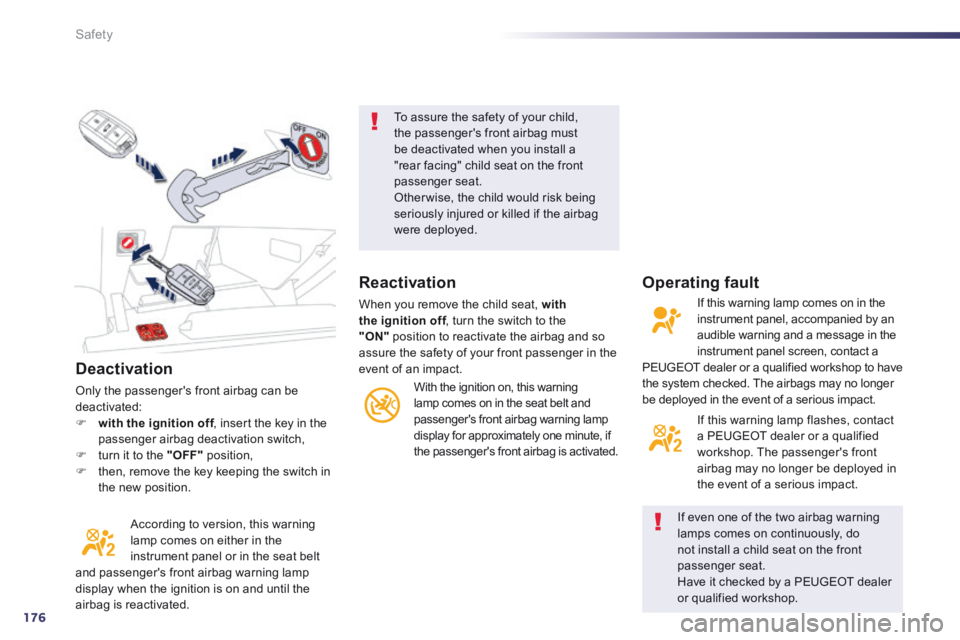
176
Safety
Deactivation
Only the passenger's front airbag can be deactivated: with the ignition off , insert the key in the with the ignition off , insert the key in the with the ignition offpassenger airbag deactivation switch, turn it to the "OFF" position, then, remove the key keeping the switch in the new position.
According to version, this warning lamp comes on either in the instrument panel or in the seat belt and passenger's front airbag warning lamp display when the ignition is on and until the airbag is reactivated.
To assure the safety of your child, the passenger's front airbag must be deactivated when you install a "rear facing" child seat on the front passenger seat. Otherwise, the child would risk being seriously injured or killed if the airbag were deployed.
If even one of the two airbag warning
lamps comes on continuously, do not install a child seat on the front passenger seat. Have it checked by a PEUGEOT dealer or qualified workshop.
Reactivation
When you remove the child seat, with the ignition off , turn the switch to the off , turn the switch to the off"ON" position to reactivate the airbag and so assure the safety of your front passenger in the event of an impact.
With the ignition on, this warning lamp comes on in the seat belt and passenger's front airbag warning lamp
display for approximately one minute, if the passenger's front airbag is activated.
Operating fault
If this warning lamp comes on in the instrument panel, accompanied by an audible warning and a message in the instrument panel screen, contact a PEUGEOT dealer or a qualified workshop to have the system checked. The airbags may no longer be deployed in the event of a serious impact.
If this warning lamp flashes, contact a PEUGEOT dealer or a qualified workshop. The passenger's front airbag may no longer be deployed in the event of a serious impact.
Page 179 of 352
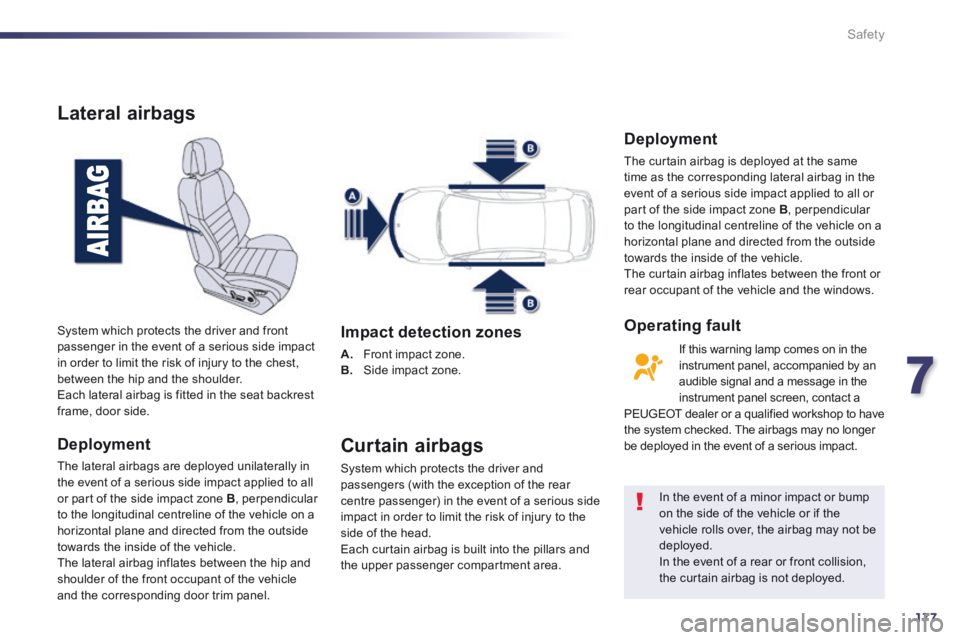
7
177
Safety
Lateral airbags
Deployment
The lateral airbags are deployed unilaterally in the event of a serious side impact applied to all or part of the side impact zone B , perpendicular to the longitudinal centreline of the vehicle on a horizontal plane and directed from the outside towards the inside of the vehicle. The lateral airbag inflates between the hip and shoulder of the front occupant of the vehicle and the corresponding door trim panel.
System which protects the driver and front passenger in the event of a serious side impact in order to limit the risk of injury to the chest, between the hip and the shoulder. Each lateral airbag is fitted in the seat backrest frame, door side.
Impact detection zones
A. Front impact zone. B. Side impact zone.
Curtain airbags
System which protects the driver and passengers (with the exception of the rear centre passenger) in the event of a serious side impact in order to limit the risk of injury to the side of the head. Each curtain airbag is built into the pillars and the upper passenger compartment area.
In the event of a minor impact or bump on the side of the vehicle or if the vehicle rolls over, the airbag may not be deployed. In the event of a rear or front collision, the curtain airbag is not deployed.
Deployment
The curtain airbag is deployed at the same time as the corresponding lateral airbag in the event of a serious side impact applied to all or part of the side impact zone B , perpendicular to the longitudinal centreline of the vehicle on a horizontal plane and directed from the outside towards the inside of the vehicle. The curtain airbag inflates between the front or rear occupant of the vehicle and the windows.
If this warning lamp comes on in the instrument panel, accompanied by an audible signal and a message in the instrument panel screen, contact a PEUGEOT dealer or a qualified workshop to have the system checked. The airbags may no longer be deployed in the event of a serious impact.
Operating fault
Page 210 of 352

208Practical information
System which manages the duration of use of certain functions to conserve a sufficient level of charge in the battery. After the engine has stopped, you can still use functions such as the audio and telematics system, windscreen wipers, dipped beam headlamps, courtesy lamps, etc. for a maximum combined duration of about forty minutes.
Energy economy mode
Switching to economy mode
A message then appears in the instrument panel screen indicating that the vehicle has switched to economy mode and the active functions are put on standby. If a telephone call is being made at this time, it
will be maintained for around 10 minutes with the Bluetooth hands-free system of your audio system.
Exiting economy mode
These functions are reactivated automatically next time the vehicle is driven. In order to resume the use of these functions immediately, start the engine and let it run: - for less than ten minutes, to use the equipment for approximately five minutes, - for more than ten minutes, to use the equipment for up to approximately thirty minutes. Let the engine run for the duration specified to ensure that the battery charge is sufficient. Do not repeatedly and continuously restart the engine in order to charge the battery. A flat battery prevents the engine from starting (refer to the "Battery" section).
Page 227 of 352
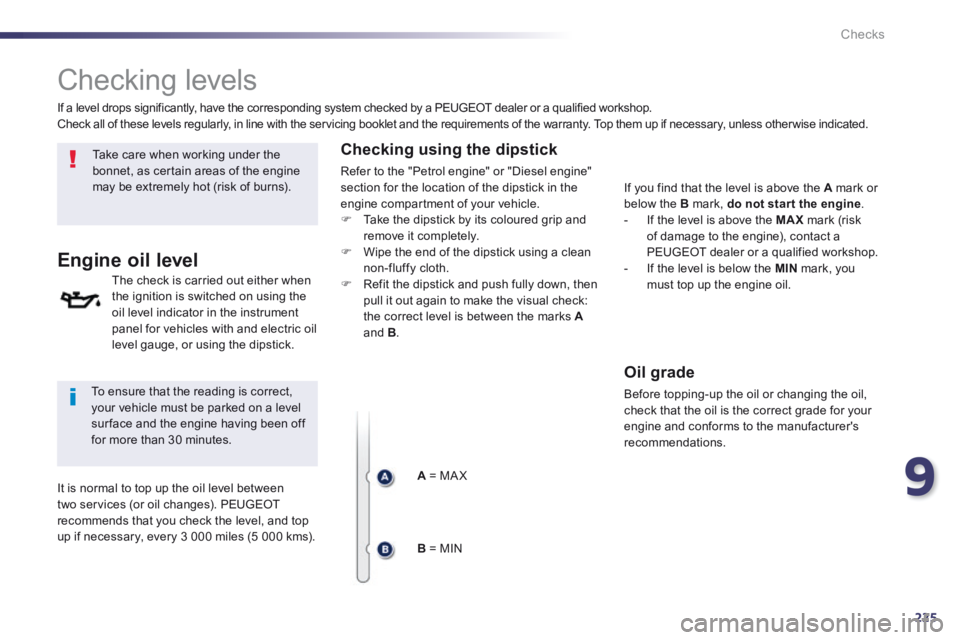
9
225
Checks
Checking levels
Take care when working under the bonnet, as certain areas of the engine may be extremely hot (risk of burns).
Engine oil level
The check is carried out either when the ignition is switched on using the oil level indicator in the instrument panel for vehicles with and electric oil level gauge, or using the dipstick.
To ensure that the reading is correct, your vehicle must be parked on a level sur face and the engine having been off for more than 30 minutes.
It is normal to top up the oil level between two services (or oil changes). PEUGEOT recommends that you check the level, and top up if necessary, every 3 000 miles (5 000 kms).
If a level drops significantly, have the corresponding system checked by a PEUGEOT dealer or a qualified workshop. Check all of these levels regularly, in line with the servicing booklet and the requirements of the warranty. Top them up if necessary, unless other wise indicated.
Checking using the dipstick
Refer to the "Petrol engine" or "Diesel engine" section for the location of the dipstick in the engine compartment of your vehicle. Take the dipstick by its coloured grip and remove it completely. Wipe the end of the dipstick using a clean non-fluffy cloth. Refit the dipstick and push fully down, then pull it out again to make the visual check: the correct level is between the marks Aand B .
A = MA X
B = MIN
If you find that the level is above the A mark or below the B mark, do not star t the engine . - If the level is above the MAX mark (risk of damage to the engine), contact a PEUGEOT dealer or a qualified workshop. - If the level is below the MIN mark, you must top up the engine oil.
Oil grade
Before topping-up the oil or changing the oil, check that the oil is the correct grade for your engine and conforms to the manufacturer's recommendations.
Page 228 of 352
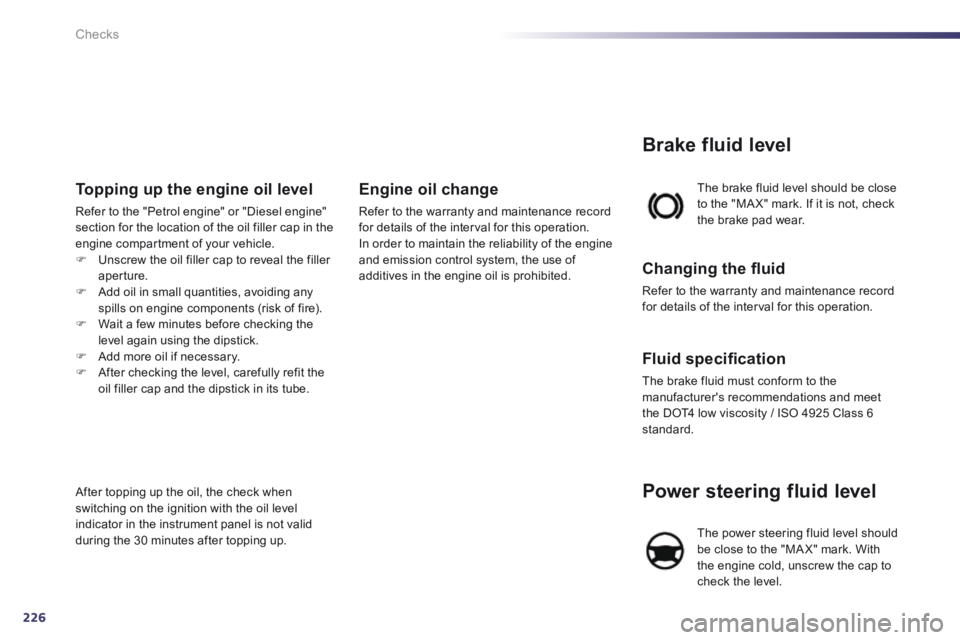
226
Checks
Power steering fluid level
The power steering fluid level should be close to the "MA X" mark. With the engine cold, unscrew the cap to check the level.
The brake fluid level should be close to the "MA X" mark. If it is not, check the brake pad wear.
Brake fluid level
Changing the fl uid
Refer to the warranty and maintenance record for details of the interval for this operation.
Fluid specifi cation
The brake fluid must conform to the manufacturer's recommendations and meet the DOT4 low viscosity / ISO 4925 Class 6 standard.
Topping up the engine oil level
Refer to the "Petrol engine" or "Diesel engine" section for the location of the oil filler cap in the engine compartment of your vehicle. Unscrew the oil filler cap to reveal the filler aperture. Add oil in small quantities, avoiding any spills on engine components (risk of fire). Wait a few minutes before checking the level again using the dipstick. Add more oil if necessary. After checking the level, carefully refit the oil filler cap and the dipstick in its tube.
After topping up the oil, the check when switching on the ignition with the oil level indicator in the instrument panel is not valid during the 30 minutes after topping up.
Engine oil change
Refer to the warranty and maintenance record for details of the interval for this operation. In order to maintain the reliability of the engine and emission control system, the use of additives in the engine oil is prohibited.
Page 229 of 352
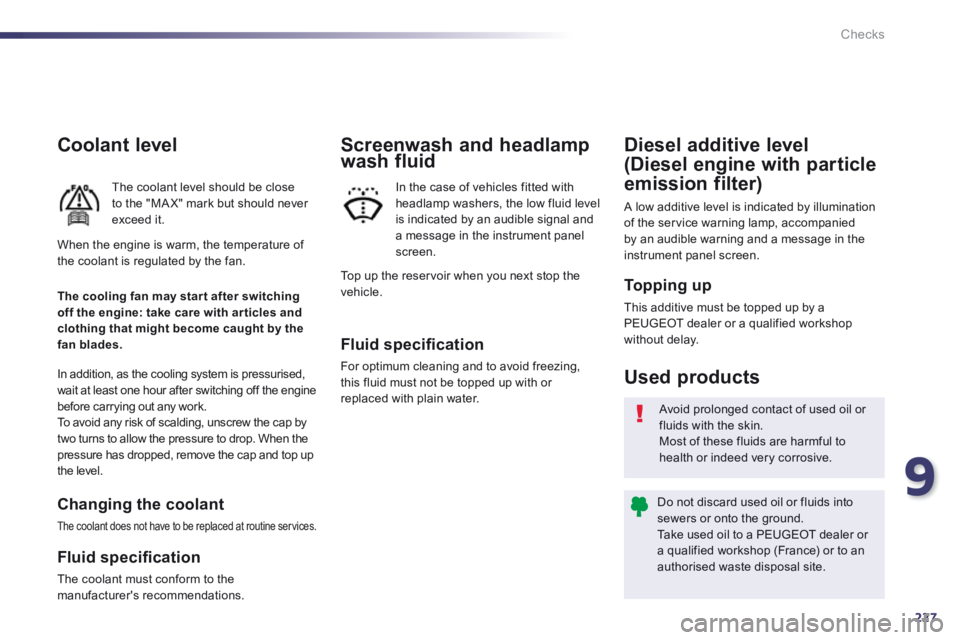
9
227
Checks
Coolant level
The coolant level should be close to the "MA X" mark but should never exceed it.
In addition, as the cooling system is pressurised, wait at least one hour after switching off the engine before carrying out any work. To avoid any risk of scalding, unscrew the cap by two turns to allow the pressure to drop. When the pressure has dropped, remove the cap and top up the level.
Changing the coolant
The coolant does not have to be replaced at routine services.
Fluid specifi cation
The coolant must conform to the manufacturer's recommendations.
Fluid specifi cation
For optimum cleaning and to avoid freezing, this fluid must not be topped up with or replaced with plain water.
Screenwash and headlamp wash fluid Screenwash and headlamp wash fluid Screenwash and headlamp
In the case of vehicles fitted with headlamp washers, the low fluid level is indicated by an audible signal and a message in the instrument panel screen.
The cooling fan may star t after switching off the engine: take care with ar ticles and clothing that might become caught by the fan blades.
Avoid prolonged contact of used oil or fluids with the skin.
Most of these fluids are harmful to health or indeed very corrosive.
Do not discard used oil or fluids into sewers or onto the ground. Take used oil to a PEUGEOT dealer or a qualified workshop (France) or to an authorised waste disposal site.
Used products
Topping up
This additive must be topped up by a PEUGEOT dealer or a qualified workshop without delay.
Diesel additive level
(Diesel engine with particle
emission filter)
A low additive level is indicated by illumination of the service warning lamp, accompanied by an audible warning and a message in the instrument panel screen. When the engine is warm, the temperature of the coolant is regulated by the fan. Top up the reservoir when you next stop the vehicle.
Page 233 of 352
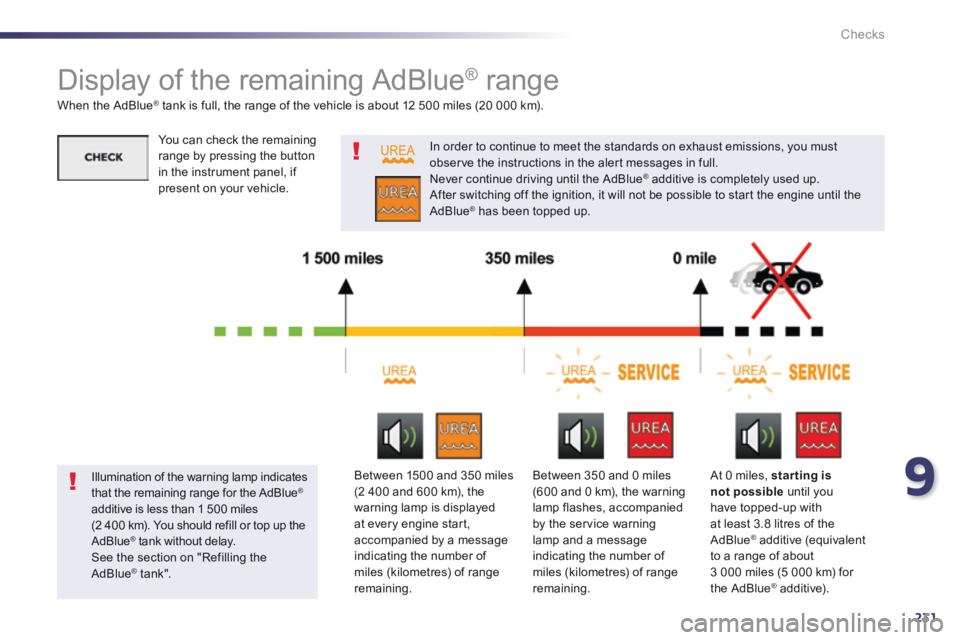
9
231
Checks
Display of the remaining AdBlue ® range
When the AdBlue ® tank is full, the range of the vehicle is about 12 500 miles (20 000 km). ® tank is full, the range of the vehicle is about 12 500 miles (20 000 km). ®
In order to continue to meet the standards on exhaust emissions, you must observe the instructions in the alert messages in full. Never continue driving until the AdBlue ® additive is completely used up. ® additive is completely used up. ®
After switching off the ignition, it will not be possible to start the engine until the AdBlue ® has been topped up. ® has been topped up. ®
Illumination of the warning lamp indicates that the remaining range for the AdBlue ® additive is less than 1 500 miles (2 400 km). You should refill or top up the
AdBlue ® tank without delay. ® tank without delay. ®
See the section on "Refilling the AdBlue ® t ank ". ® t ank ". ®
Between 1500 and 350 miles (2 400 and 600 km), the warning lamp is displayed at every engine start, accompanied by a message indicating the number of miles (kilometres) of range remaining.
Between 350 and 0 miles (600 and 0 km), the warning lamp flashes, accompanied by the service warning lamp and a message indicating the number of miles (kilometres) of range remaining.
At 0 miles, star ting is not possible until you have topped-up with at least 3.8 litres of the AdBlue ® additive (equivalent ® additive (equivalent ®
to a range of about 3 000 miles (5 000 km) for the AdBlue ® additive). ® additive). ®
You can check the remaining range by pressing the button in the instrument panel, if present on your vehicle.